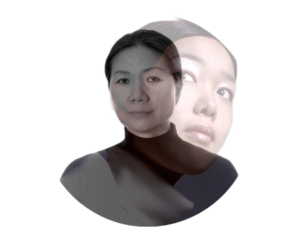Spirituality: Performance as Meditation
Kimsooja’s art is filled with ties to the spiritual world. Performance became an actual practice of meditation for her. In an interview with Mary Jane Jacob between 2001 and 2003, Kimsooja states that the “most important thing to arise out of these performances is (my) own experience of self and awakeness. That’s how (I) continue to ask deeper questions to the world and myself. That is the enlightenment (I) encounter while doing this kind of performance.”[160] Kimsooja grew up practicing Christianity in her family home, but Korean life was dominated by Buddhism, Confucianism, and Shamanism. It was inevitable, therefore, for these other religions to infiltrate her work and life. Her interest in Buddhism and Buddhist philosophy are the most apparent in her work. Kimsooja’s sewing of fabric and choice of using bedcover bundles in her Bottari and Cities on the Move series are evident not only in her childhood and family life, but also in the meditations on the “impermanence of our lives” that played an essential notion in her work.[161] The bedcover and bed represent the frame of life and death, and the impermanency of both because the bed is a site of both. They frame our existence.[162] In an interview with Nicolas Bourriaud in 2003, Kimsooja explains that her “immediate perceptions and decisions in creating art meet the disciplines of Buddhism” but that making art and living her life were not consciously borrowed from Buddhist theories. She stopped reading for a decade to concentrate on her thoughts, free from any distractions. Once she started reading again, particularly on Buddhism, Kimsooja noticed the similarities in her work and perceptions of life.[163]
Growing up in Korea, the code of moral conduct influenced by Confucianism still influenced Kimsooja. Dating 2,500 years back, Confucianism began in China and was most concerned with morality, inner virtue, and the most profound respect for one’s community and its values.[164] It laid the foundation for Chinese culture and made its way into Korea by the fifth century CE, blending the pre-existing Korean culture and institutions. Korean Confucians used Confucian ideas that advocated hierarchy and moral leadership, particularly in bolstering their state bureaucracy and providing a rigid social structure. Korean Confucianism matured during the Choson dynasty (1392-1910), and Neo-Confucianism, its recalibrated form, dislodged Buddhism as a rival system (intellectual and philosophical). The leading Korean Confucian tradition that Kimsooja seems to carry with her is the maintained social hierarchies. As mentioned previously, these hierarchies meant that women were disadvantaged and always expected to be subordinate to men: sons, husbands, and feathers. This created a harmonious society. Where Kimsooja displaces this Confucian value is her interpretation of the Needle Woman as cutting through or penetrating the social fabric.
Confucianists believed they emphasized the practical everyday life of fulfilling social relations and didn’t take Buddhists seriously. Confucian scholars and philosophers tried to undermine and discredit Buddhist teaching and beliefs whenever possible. Confucians saw Buddhists failing to achieve filial and social obligations because they removed themselves from both.[165] Regarding Catholicism and Confucian-Catholics, the earliest Korean converts to Catholicism were Confucian-strained scholars from aristocratic families. Kimsooja, a Catholic in Korean society with a long Confucian and Shamanistic tradition, certainly wasn’t alone. Confucian aspects of early Catholicism reflected a transcultural interaction between the two rules. The similarities both highlighted their moral priorities.[166]
In terms of the Needle Woman and Kimsooja’s spirituality, the Buddhist tradition has the most significant influence. Not only through her words but through visual clues do the spiritual elements in Needle Woman become evident. Her outfit in the videos, a dark grey robe, has been described as a monk outfit. Although Buddhist monks on the internet wear bright orange robes, the simplicity of the uniform is similar to Kimsooja’s. And in fact, Kimsooja viewed her artistic practice as like that of a Buddhist monk.[167]
Simplicity is one of the main teachings of Buddhism, and appearance certainly matches that.[168] Materialism is not a mindset that Kimsooja or Buddhists have. In terms of the performance itself, Kimsooja standing in the middle of each city was considered a meditation in itself. Meditation is also a part of natural human experience. Meditation is “a mental and physical course of action that a person uses to separate themselves from their thoughts and feelings to become fully aware.”[169] Although we often think of meditation in connection with a religious element, such as the Buddhist teachings, this isn’t always the case. In Buddhism, mediation involves the body and mind as a single entity.[170] At the beginning of Kimsooja’s performance, as described by her in the interview with Mary Jane Jacob, she had “difficulty resisting all the energies from people coming at (me). By the middle of the performance, (I) was centered and focused and could become liberated from them. In the beginning, (my) body was very, very tense, but in the end, (I) was just smiling, liberated from all attention…(I) was in complete enlightenment.”[171] In the most general definition of meditation, Kimsooja takes control of her mind and becomes more aware.
Although the lines between the feminist and spiritual readings in the work of Kimsooja aren’t quite as blurred as those in Mariko Mori’s, they are still drawn. The parallels are certainly harder to draw, with the spiritual aspects of Kimsooja’s Needle Woman being quickly apparent but the feminist ideologies more challenging to tie in. Although they don’t cross into one another as much as in Mori’s, they are still there. Kimsooja’s spirituality, artistic expression, and meditation through art have been significant to building her identity, much like the women of other East Asian civilizations practicing Daoism, Confucianism, and Buddhism. Kimsooja’s performative meditation was a genre in which she thrived and continues to thrive present day. She liberates herself as the Needle Woman and finds her own form of enlightenment. Where Kimsooja finds peace engaging with the whole picture of the world, Mariko Mori finds peace inserting herself into alternate worlds or realities, such as the Esoteric Cosmos.[172]
